Small bedrooms don’t have to be tight or boring. You can create an attractive, cosy, and practical space with the appropriate methods. Smart furniture, layouts, and light colours may make small spaces look bigger. These 20 modest bedroom ideas are presented so you may easily implement them.
1. Paint Walls Light Colours
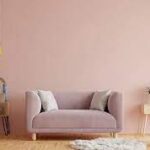
Light colours like white, beige, and mild grey instantly open up a room. Lighter tones reflect natural and artificial light, whereas dark shades absorb light and close in. This easy adjustment can visibly extend your room without construction.
Use pastels like mint green, blush pink, or powder blue if white is monotonous. Adding neutral bedding and drapes to light-colored walls improves the impression. Painting the ceiling the same light colour lets the walls and ceiling mix, decreasing boundaries.
2. Store Vertically
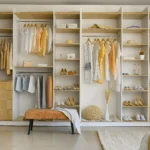
When floor space is limited, look skyward. Tall wardrobes, bookshelves, and floating wall units maximise space without cluttering the floor. Books, plants, and decor can be stored on narrow wall-mounted shelves above the bed or in empty corners.
Ceiling-high wardrobes use every inch of height and are functional. Vertical storage makes the area look taller and holds vital. It also keeps your bedroom neat, fashionable, and utilitarian by displaying ornamental objects without taking up space.
3. Pick a Storage Bed
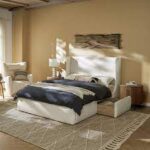
In a small room, your bed takes up the most space, so choose one with storage. Storage beds with drawers or lift-up compartments are great for off-season clothes, bedding, and shoes. The absence of cumbersome dressers saves floor space. Even with a conventional bed, you can utilise under-bed organisers, storage bins, or rolling drawers.
These hidden spaces help reduce clutter while keeping things accessible. With its comfort and functionality, a storage bed maximises space without compromising sleep quality.
4. Hang Nightstands Float
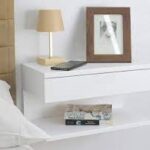
Bulky bedside tables take up floor space, making a small bedroom feel cluttered. Although wall-mounted, floating nightstands keep the floor uncluttered, providing a sleek, open impression.
Lamps, alarm clocks, and phones fit perfectly in them. Drawers provide covert storage for small objects in some versions. Wall-mounted lighting and floating designs save space. Besides utility, floating nightstands are trendy and basic. They’re functional, easy to clean, and smart for room layout and appearance.
5. Add Depth Mirrors
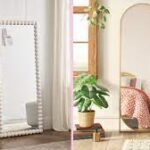
Mirrors always make a tiny place look bigger. They brighten and widen the space by reflecting natural and artificial light. A floor-to-ceiling mirror or mirrored wardrobe doors can double space.
A mirror opposite a window maximises light reflection, creating a light, airy effect. Clustered decorative wall mirrors provide flair and usefulness. Mirrors can give your small bedroom depth and dimension, making it lively and inviting without major changes.
6. Use Multipurpose Furniture
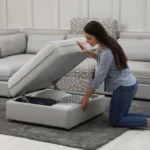
Every piece of furniture in a small bedroom should be multipurpose. Sofa beds are seating and sleeping spaces. Desks that fold out from the wall can double as vanity tables. Ottomans with secret storage seat and store clothes or blankets. Utility without clutter is maximised by this multifunctional furniture. Choose compact, customisable designs when purchasing. Multipurpose pieces not only save space but also reduce the number of items in the room, keeping it organized, flexible, and perfect for both relaxation and productivity.
7. Clear the Floor
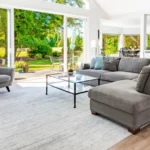
Rooms can appear smaller with busy floors. To avoid this, use furniture with legs, which reveal floor space underneath and provide an open feel. Wall-mounted shelving, nightstands, and TVs clear floor space.
Avoid oversized rugs; instead, use smaller ones that define spaces without overwhelming them. Keep baskets or storage boxes under the bed, but don’t leave things around. Clear floors make a space look bigger and are easier to clean.
8. Maximise Under-Bed Space
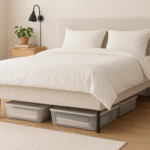
The area under your bed often goes unused, yet it’s one of the most valuable storage spots in a small room. Seasonal clothing, bedding, and shoes go in flat bins, rolling drawers, or vacuum-sealed bags. Buy a bed skirt to disguise the storage to make it look neat.
Choose beds with built-in drawers for easy access. This method saves closet space and organises essentials. Under-bed storage turns unused space into a practical solution without adding furniture.
9. Choose Wall-Mounted Lighting
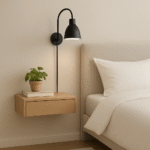
Small bedrooms lack space for table and floor lighting. Wall-mounted sconces, reading lights, or hanging pendant lamps are excellent alternatives. They free up nightstand or floor space while still providing enough light for reading or relaxing. Wall lamps with adjustable angles provide flair and usefulness.
Installing lights on walls also eliminates clutter and helps the room look streamlined. Choosing warm-toned lighting makes the space cozy, while smart lighting options add flexibility without compromising on space or design.
10. Choose Slim Furniture
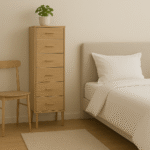
When working with limited space, chunky furniture can overwhelm the room. Slim drawers, tiny wardrobes, and thin-legged chairs fit in tight spaces without taking up too much space. Look for pieces that offer storage without being bulky, such as a tall narrow dresser instead of a wide one.
Sleek designs in neutral tones keep the space open and modern. Slim furniture not only saves space but also allows for easy movement. Slim furniture offers balance and harmony, making your area efficient and uncluttered.
11. Create a Feature Wall.
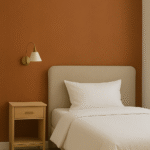
Adding charm to a tiny bedroom doesn’t always necessitate additional furniture or decor. A feature wall behind the bed may instantly shift the atmosphere. To create a fashionable backdrop, use wallpaper, textured panels, or a bright paint colour. This draws the eye up and out, creating the illusion of a larger room.
Keep the remaining walls neutral to prevent overwhelming the space. A feature wall creates a focal point without adding unnecessary clutter. It’s a simple, inexpensive method to make a tiny room stand out while remaining balanced.
12. Add a Loft Bed.
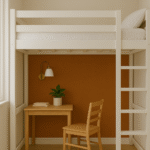
If your ceiling height allows, a loft bed is an excellent option to increase the functionality of your home. Raising the bed creates space underneath for a desk, reading area, or closet. This plan works great in compact apartments, dorms, or children’s bedrooms when every inch counts.
Loft beds make good use of vertical space, providing a separate area for sleeping and working. Combining the arrangement with appropriate lighting maintains the space bright and comfortable. A loft bed adds individuality while solving space problems in a unique and functional manner.
13. Use Foldable Furniture.
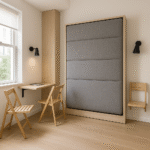
Foldable furniture is a lifesaver for small bedrooms. Foldable chairs, wall-mounted desks, and Murphy beds may be stored when not in use, rapidly freeing up floor space. This adaptability enables you to use the same space for numerous activities, such as working during the day and sleeping at night.
Foldable designs have become more elegant and robust, making them appropriate for modern households. Investing in collapsable furniture ensures that you are never short on space while remaining comfortable. It’s a versatile solution for anyone who values both utility and mobility.
14. Try Sliding Doors.
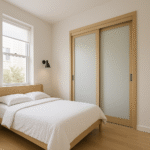
Traditional swing doors require a lot of clearing space, which is inconvenient in tiny bedrooms. Sliding doors, whether for closets or room entry, reduce space while providing a streamlined appearance. Mirrored sliding doors provide depth and brightness, while frosted glass versions provide privacy while remaining elegant.
Sliding wardrobe doors also allow you to position furniture closer to the closet without concern for door clearance. They’re smooth, contemporary, and quite practical, making them a great addition. By replacing traditional doors with sliding ones, you obtain more usable space and a clutter-free layout.
15. Install Built-in Wardrobes.
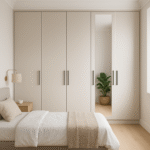
Built-in closets are custom-designed to meet your bedroom’s exact dimensions, making them ideal for small areas. Unlike freestanding wardrobes, they have no uncomfortable gaps and may be built from floor to ceiling.
This design maximises storage for clothes, shoes, and accessories while integrating in with the existing walls. To improve efficiency, built-ins may have sliding doors, mirrored panels, or concealed chambers. The end effect is a clean, sleek appearance without cumbersome furnishings. Although built-ins may cost more initially, they save space, add value to your home, and keep everything organized in a compact layout.
16. Select Light Curtains.
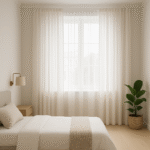
Heavy curtains make a tiny bedroom appear darker and more cramped. Instead, opt for sheer or light-colored fabrics that allow natural light to filter in. Light curtains create an airy atmosphere while maintaining privacy.
Soft materials such as linen or cotton look great against light walls, making the room appear larger. If you need blackout functionality for sleep, consider layered options sheer curtains for the day and light-blocking roller blinds for the night. This mix maintains the area feeling fresh and open while also allowing for flexibility. Light curtains are a simple yet effective way to change the atmosphere of your bedroom.
17. Keep the Decor Minimal.
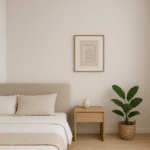
Small rooms can quickly feel cluttered with too many decorative items. Rather than covering every surface, concentrate on a few key components. A framed artwork, a stylish lamp, or a plant can make a big impact without overwhelming the space.
Minimal decor keeps the room looking tidy while also highlighting its practicality. Prioritise utilitarian dcor, such as storage baskets or shelves, which are both decorative and functional. A minimalist approach maintains the area peaceful and tidy, making your small bedroom feel cosy, airy, and welcoming rather than crowded or chaotic.
18. Use Rugs to Define Space
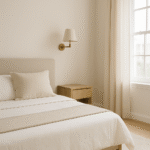
Rugs are a fantastic method to separate distinct regions in a tiny bedroom without physically dividing the space. A rug under the bed creates a visual anchor, making the sleeping area feel cozy and intentional. Opt for smaller rugs with simple patterns instead of large, bold designs that might overwhelm. Light-colored or neutral carpets increase the sense of space while providing warmth underfoot. By selecting the appropriate size, you can create structure and texture without clutter. Rugs add softness and character to a tiny area, achieving an effective balance of style and comfort.
19. Mount Your TV on the Wall
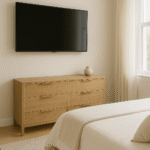
In small bedrooms, every inch counts. Instead of placing your television on a dresser or stand, mount it directly to the wall. This frees up surface space for other essentials and reduces bulk. Wall-mounted TVs also create a cleaner, more streamlined look. You can use adjustable wall mounts to angle the screen for better viewing from the bed. Pair the setup with hidden cable organizers to keep wires out of sight. A mounted TV not only saves space but also gives your room a modern, polished appearance without adding extra furniture.
20. Add Plants for Freshness
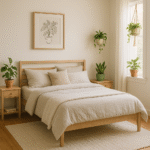
Plants are a simple way to add vitality and freshness to a modest bedroom. Instead of large floor plants, opt for smaller potted ones on shelves, window sills, or hanging planters. Greenery improves air quality, adds colour, and promotes calm. Hanging plants are especially useful because they don’t take up floor or surface space. Low-maintenance plants like snake plants, succulents, or pothos are ideal for bedrooms. Plants balance minimal decor with natural beauty, creating a cozy yet vibrant atmosphere. Even in the smallest room, a touch of green makes the space feel more alive and welcoming.
Conclusion
Small bedrooms can be transformed into cozy, stylish retreats with the right design choices. By focusing on light colors, smart storage, and multifunctional furniture, you can maximize every inch of space. Minimal decor, clever layouts, and small touches like mirrors and plants help make the room feel larger, brighter, and more inviting. Remember, size doesn’t limit comfort or style—creativity does.
